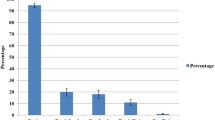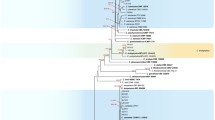Abstract
Anthracnose, caused by Colletotrichum species is a highly limiting disease for the production of the tropical fruit tree crop, soursop (Annona muricata L.). In this study, 83 single-spore isolates of Colletotrichum were obtained from diseased soursoup tissues and subjected to a species complex-specific PCR assay. The isolates were identified as C. gloeosporioides sensu lato (n = 60), C. boninense s. lat. (n = 22), or C. acutatum s. lat. (n = 1). A subset of 21 selected isolates was identified to species level by means of a multi-locus phylogenetic analysis using sequences from the ITS region and partial sequences of the actin, β-tubulin-2, glyceraldehyde-3-phosphate dehydrogenase, and chitin synthase-1 genes. The multi-locus phylogenetic analysis resolved C. theobromicola, C. tropicale, C. siamense, and C. gloeosporioides sensu stricto in the C. gloeosporioides complex; C. karstii and one undetermined species in the C. boninense complex; as well as one undetermined species in the C. acutatum complex. Significant differences in anthracnose severity were observed between Colletotrichum species when tested for pathogenicity on attached twigs of soursop cv. Elita. Colletotrichum theobromicola and C. tropicale were associated with high and intermediate virulence, respectively, whereas the remaining species were associated with low virulence.

Similar content being viewed by others
References
Afanador-Kafuri, L., Minz, D., Maymon, M., & Freeman, S. (2003). Characterization of Colletotrichum isolates from tamarillo, passiflora, and mango in Colombia and identification of a unique species from the genus. Phytopathology, 93(5), 579–587.
Alahakoon, P. W., Brown, A. E., & Sreenivasaprasad, S. (1994). Cross-infection potential of genetic groups of Colletotrichum gloeosporioides on tropical fruits. Physiological and Molecular Plant Pathology, 44(2), 93–103.
Álvarez, E., Ospina, C., Mejía, J. F., & Llano, G. A. (2004). Caracterización morfológica, patogénica y genética del agente causal de la antracnosis (Colletotrichum gloeosporioides) en guanábana (Annona muricata) en el Valle del Cauca. Fitopatología Colombiana, 28, 1–8.
Cai, L., Hyde, K. D., Taylor, P. W. J., Weir, B. S., Waller, J., Abang, M. M., et al. (2009). A polyphasic approach for studying Colletotrichum. Fungal Diversity, 39, 183–204.
Cannon, P. F., Bridge, P. D., & Monte, E. (2000). Linking the past, present, and future of Colletotrichum systematics. In D. Prusky, S. Freeman, & M. Dickman (Eds.), Colletotrichum: Host Specificity, Pathology, and Host-Pathogen Interaction (pp. 1–20). St. Paul: American Phytopathological Society.
Cannon, P. F., Buddie, A. G., & Bridge, P. D. (2008). The typification of Colletotrichum gloeosporioides. Mycotaxon, 104, 189–204.
Cannon, P. F., Damm, U., Johnston, P. R., & Weir, B. S. (2012). Colletotrichum - current status and future directions. Studies in Mycology, 73(1), 181–213.
Carbone, I., & Kohn, L. M. (1999). A method for designing primer sets for speciation studies in filamentous ascomycetes. Mycologia, 91(3), 553–556.
Crouch, J. A., Clarke, B. B., & Hillman, B. I. (2009). What is the value of ITS sequence data in Colletotrichum systematics and species diagnosis? A case study using the falcate-spored graminicolous Colletotrichum group. Mycologia, 101(5), 648–656.
Damm, U., Mostert, L., Crous, P. W., & Fourie, P. H. (2008). Novel Phaeoacremonium species associated with necrotic wood of Prunus trees. Persoonia, 20, 87–102.
Damm, U., Cannon, P. F., Woudenberg, J. H. C., & Crous, P. W. (2012a). The Colletotrichum acutatum species complex. Studies in Mycology, 73(1), 37–113.
Damm, U., Cannon, P. F., Woudenberg, J. H. C., Johnston, P. R., Weir, B. S., Tan, Y. P., et al. (2012b). The Colletotrichum boninense species complex. Studies in Mycology, 73(1), 1–36.
Freeman, S., Katan, T., & Shabi, E. (1998). Characterization of Colletotrichum species responsible for anthracnose diseases of various fruits. Plant Disease, 82(6), 596–605.
Freeman, S., Shabi, E., & Katan, T. (2000). Characterization of Colletotrichum acutatum causing anthracnose of anemone (Anemone coronaria L.). Applied and Environmental Microbiology, 66(12), 5267–5272.
Glass, N. L., & Donaldson, G. C. (1995). Development of primer sets designed for use with the PCR to amplify conserved genes from filamentous ascomycetes. Applied and Environmental Microbiology, 61(4), 1323–1330.
Huang, F., Chen, G. Q., Hou, X., Fu, Y. S., Cai, L., Hyde, K. D., et al. (2013). Colletotrichum species associated with cultivated citrus in China. Fungal Diversity, 61(1), 61–74.
International Centre for Underutilized Cultures (ICUC). (2002). Fruits for the future: Annona. Available from: http://www.cropsforthefuture.org/publication/Factsheets/Factsheet-annona.pdf [Nov, 2012]. Institute of Irrigation and Development Studies, University of Southampton, Southampthon, UK.
Kück, P., & Meusemann, K. (2010). FASconCAT: convenient handling of data matrices. Molecular Phylogenetics and Evolution, 56(3), 1115–1118.
Lima, N. B., Batista, M., De Morais, M. A., Jr., Barbosa, M. A. G., Michereff, S. J., Hyde, K. D., et al. (2013). Five Colletotrichum species are responsible for mango anthracnose in northeastern Brazil. Fungal Diversity, 61(1), 75–88.
Liu, F., Cai, L., Crous, P. W., & Damm, U. (2013a). Circumscription of the anthracnose pathogens Colletotrichum lindemuthianum and C. nigrum. Mycologia, 105(4), 844–860.
Liu, F., Damm, U., Cai, L., & Crous, P. W. (2013b). Species of the Colletotrichum gloeosporioides complex associated with anthracnose diseases of Proteaceae. Fungal Diversity, 61(1), 89–105.
Love, K., & Paull, R. E. (2011). Soursop. Fruits and Nuts F_N-22. USA: College of Tropical Agriculture and Human Resources, University of Hawai’i, HI.
Maddison, W. P. & Maddison, D. R. (2011). Mesquite: a modular system for evolutionary analysis. Version 2.75. Available from: http://mesquiteproject.org. [Mar, 2013].
Mills, P. R., Sreenivasaprasad, S., & Brown, A. E. (1992). Detection and differentiation of Colletotrichum gloeosporioides isolates using PCR. FEMS Microbiology Letters, 98(1), 137–143.
O’Connell, R. J., Thon, M. R., Hacquard, S., Amyotte, S. G., Kleemann, J., et al. (2012). Life-style transitions in plant pathogenic Colletotrichum fungi deciphered by genome and transcriptome analyses. Nature Genetics, 44, 1060–1065.
Pareek, S., Yahia, E. M., Pareek, O. P., & Kaushik, R. A. (2011). Postharvest physiology and technology of Annona fruits. Food Research International, 44(7), 1741–1751.
Phoulivong, S. (2011). Colletotrichum, naming, control, resistance, biocontrol of weeds and current challenges. Current Research in Environmental & Applied Mycology, 1(1), 53–73.
Phoulivong, S., Cai, L., Chen, H., McKenzie, E. H. C., Abdelsalam, K., Chukeatirote, E., et al. (2010). Colletotrichum gloeosporioides is not a common pathogen on tropical fruits. Fungal Diversity, 44(1), 33–43.
Phoulivong, S., McKenzie, E. H. C., & Hyde, K. D. (2012). Cross infection of Colletotrichum species; a case study with tropical fruits. Current Research in Environmental & Applied Mycology, 2(2), 99–111.
Pileggi, S. A., Vieira de Oliveira, S. F., Andrade, C. W., Vicente, V. A., Dalzoto, P. d. R., da Cruz, G., et al. (2009). Molecular and morphological markers for rapid distinction between two Colletotrichum species. Canadian Journal of Microbiology, 55(9), 1076–1088.
Posada, D. (2008). jModelTest: phylogenetic model averaging. Molecular Biology and Evolution, 25(7), 1253–1256.
Prihastuti, H., Cai, L., Chen, H., McKenzie, E. H. C., & Hyde, K. D. (2009). Characterization of Colletotrichum species associated with coffee berries in northern Thailand. Fungal Diversity, 39, 89–109.
Rojas, E. I., Rehner, S. A., Samuels, G. J., Van Bael, S. A., Herre, E. A., Cannon, P., et al. (2010). Colletotrichum gloeosporioides s.l. associated with Theobroma cacao and other plants in Panamá: multilocus phylogenies distinguish host-associated pathogens from asymptomatic endophytes. Mycologia, 102(6), 1318–1338.
Ronquist, F., Teslenko, M., van der Mark, P., Ayres, D., Darling, A., Höhna, S., et al. (2012). MrBayes v. 3.2: efficient Bayesian phylogenetic inference and model choice across a large model space. Systematic Biology, 61(3), 539–542.
Schena, L., Mosca, S., Cacciola, S. O., Faedda, R., Sanzani, S. M., Agosteo, G. E., et al. (2013). Species of the Colletotrichum gloeosporioides and C. boninense complexes associated with olive anthracnose. Plant Pathology. doi:10.1111/ppa.12110.
Sreenivasaprasad, S., Sharada, K., Brown, A. E., & Mills, P. R. (1996). PCR-based detection of Colletotrichum acutatum on strawberry. Plant Pathology, 45(4), 650–655.
Stöver, B. C., & Müller, K. F. (2010). TreeGraph 2: combining and visualizing evidence from different phylogenetic analyses. BMC Bioinformatics, 11, 7. doi:10.1186/1471-2105-11-7.
Sutton, B. C. (1992). The genus Glomerella and its anamorph Colletotrichum. In J. A. Bailey & M. J. Jeger (Eds.), Colletotrichum: Biology, Pathology and Control (pp. 1–26). Wallingford: CAB International.
Tamura, K., Peterson, D., Peterson, N., Stecher, G., Nei, M., & Kumar, S. (2011). MEGA5: molecular evolutionary genetics analysis using maximum likelihood, evolutionary distance, and maximum parsimony methods. Molecular Biology and Evolution, 28(10), 2731–2739.
Templeton, M. D., Rikkerink, E. H., Solon, S. L., & Crowhurst, R. N. (1992). Cloning and molecular characterization of the glyceraldehyde-3-phosphate dehydrogenase-encoding gene and cDNA from the plant pathogenic fungus Glomerella cingulata. Gene, 122(1), 225–230.
Than, P. P., Jeewon, R., Hyde, K. D., Pongsupasamit, S., Mongkolporn, O., & Taylor, P. W. J. (2008). Characterization and pathogenicity of Colletotrichum species associated with anthracnose on chilli (Capsicum spp.) in Thailand. Plant Pathology, 57(3), 562–572.
Udayanga, D., Manamgoda, D. S., Liu, X., Chukeatirote, E., & Hyde, K. D. (2013). What are the common anthracnose pathogens of tropical fruits? Fungal Diversity, 61(1), 165–179.
Weir, B. S., Johnston, P. R., & Damm, U. (2012). The Colletotrichum gloeosporioides species complex. Studies in Mycology, 73(1), 115–180.
White, T. J., Bruns, T., Lee, S., & Taylor, J. (1990). Amplification and direct sequencing of fungal ribosomal RNA genes for phylogenetics. In M. A. Innis, D. H. Gelfand, & J. J. Sninsky (Eds.), PCR Protocols: A Guide to Methods and Applications (pp. 315–322). San Diego: Academic Press.
Acknowledgments
We are grateful to Corporación BIOTEC, Ministerio de Agricultura y Desarrollo Rural de Colombia, Agencia Colombiana de Cooperación Internacional (ACCI), and COLCIENCIAS for their financial support. We thank Dr Jairo Castaño-Zapata for his contributions to this research; Juan B. Cuasquer (Systems Engineer, CIAT); and Elizabeth L. McAdam and Matthew Blair for reviewing the manuscript.
Author information
Authors and Affiliations
Corresponding author
Rights and permissions
About this article
Cite this article
Álvarez, E., Gañán, L., Rojas-Triviño, A. et al. Diversity and pathogenicity of Colletotrichum species isolated from soursop in Colombia. Eur J Plant Pathol 139, 325–338 (2014). https://doi.org/10.1007/s10658-014-0388-7
Accepted:
Published:
Issue Date:
DOI: https://doi.org/10.1007/s10658-014-0388-7




